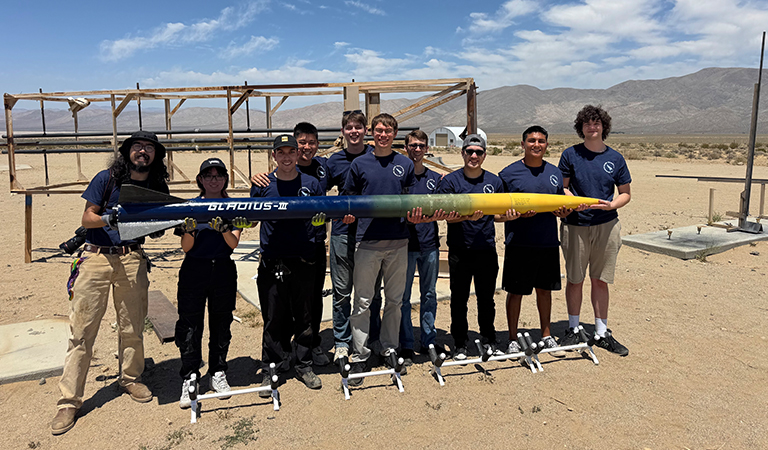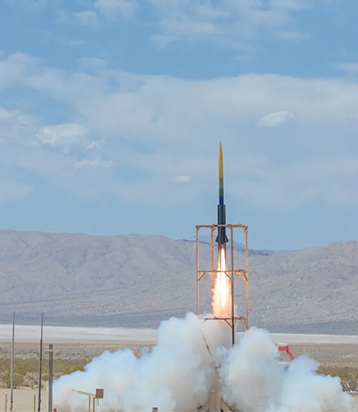Harvey Mudd’s MARC Team Successful at FAR Rocketry Competition
July 28, 2025
The Mudd Amateur Rocketry Club (MARC) launched its most successful rocket to date, marking a milestone in the Harvey Mudd College student group’s multi-year journey toward competitive rocketry excellence. The rocket, Gladius III, soared to over 17,000 feet and returned fully intact, earning MARC third place on the competition leaderboard at the Friends of Amateur Rocketry (FAR) site in California’s Mojave Desert.
“Seeing our rocket ignite, feeling the initial roar and flash of fire, that’s something everyone just needs to experience,” says Drake Gonzales ’27, who helped with avionics and rocket assembly. “FAR was a great opportunity to bond with the team and fall even more in love with rocketry.”
The launch, held Sunday, June 8, was the culmination of months of design, fabrication and last-minute problem-solving by students across class years and disciplines. Spencer Michaelson ’28 described the experience as both technically challenging and emotionally intense: He had the “nerve-wracking honor of crawling beneath the fully vertical, fueled rocket to insert the ignitor, the final step before launch,” he says.
Michaelson worked on structural design, motor assembly and water jetting components for Gladius III. He says, “About a minute after liftoff, when we saw the main chute deploy successfully, the entire team erupted into cheers and hugs, so loud that the staff had to ask us to quiet down for the next launch.”
Pierce Gruber ’25, structures lead, says Gladius III represented a “complete redesign” after structural failures in previous years. “We rebuilt everything from the fins to the epoxy bonding methods. There were moments I thought, ‘There’s no way this thing will fly.’ But we came in the next day and figured it out.”
The rocket featured innovations like custom centering rings, epoxy optimization, a new avionics bay and an improvised GPS solution. “To help us zero in on its exact position, we had mounted several tracking devices inside the rocket, including a $165 GPS tracker and a burner phone with the Life360 location-sharing app installed,” says Nikolas Hall ’25, MARC’s outgoing president. “Ironically, the tracker didn’t work, and it was the cell phone that ultimately led us to the rocket.”
Jacob Fain ’26, associate structures lead, says the team “pulled together to finish building Gladius III just hours before launching. We solved a number of critical problems, which was a thrilling challenge that ultimately grew my confidence as an engineer.”

Other team members contributed across subsystems, from avionics and parachutes to structural design and documentation. Felix Peng ’28 helped assemble the rocket and its nose cone, Wilson Zambrano ’26 helped assemble the motor on-site, Rai Wandeler ’28 set up and ran the rocket’s avionics system, Ben Simpson ’28 designed its scientific payload and incoming MARC president Naomi Horiguchi ’26 led recovery system efforts and coordinated rocket assembly. Several members, including avionics lead Xiyuan (Amy) Liu ‘26, were unable to attend the launch but worked on the rocket throughout the preceding year. Additional support for the team came from Machine Shop Manager Drew Price, Professor of Engineering Leah Mendelson, R. Michael Shanahan Professor of Chemistry and Associate Dean of Faculty Katherine Van Heuvelen and Administrative Coordinator Andrea Caldera. The rocket was funded by the HMC Shanahan Fund for student-directed projects.
“When during those first few seconds Gladius III shot up in a perfect, straight line of smoke, all the work over the past four years was instantly worth it,” says Gruber.
